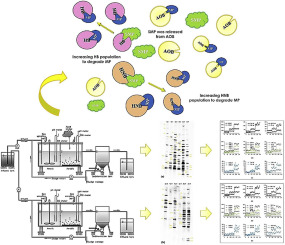Chemosphere ( IF 8.8 ) Pub Date : 2018-03-15 , DOI: 10.1016/j.chemosphere.2018.03.084 Jarungwit Boonnorat , Somkiet Techkarnjanaruk , Ryo Honda , Sivakorn Angthong , Nimaradee Boonapatcharoen , Sutharat Muenmee , Pradthana Prachanurak

|
This research investigates the toxic organic compounds biodegradation efficiency of two-stage activated sludge systems with (bioaugmented) and without aged sludge bioaugmentation (non-bioaugmented). The influent was a mixture of leachate and agriculture wastewater (1:1, v/v), used as the representative high strength wastewater. The bioaugmented and non-bioaugmented systems were operated in parallel, with three levels (low, moderate, and high) of concentrations of organics, nitrogen, and toxic organic compounds in the influent (conditions 1, 2, and 3). The results showed that both systems could efficiently degrade the organic compounds. Nevertheless, the toxic organic compounds biodegradation efficiency of the bioaugmented system was higher than that of the non-bioaugmented one. The bioaugmentation enhanced the overall removal efficiency under conditions 1 and 2. However, the bioaugmented system became less effective under condition 3. Further analysis indicated that the bacterial groups essential to the toxic organic compounds biodegradation were abundant in the aged sludge, including heterotrophic bacteria, heterotrophic nitrifying bacteria, and nitrifying bacteria. The abundance of the effective bacteria improved the biodegradation and wastewater treatment performance of the bioaugmented system. In essence, the aged sludge bioaugmentation is a viable and eco-friendly solution to improving the treatment efficiency of the biological activated sludge system, despite limited biodegradation efficiency in an elevated compounds-concentration environment.
中文翻译:

在两阶段活性污泥系统中使用老化污泥生物增强技术来增强高强度废水中有毒有机物的生物降解
这项研究调查了两阶段活性污泥系统(有生物强化)和无老化污泥生物强化(非生物强化)的有毒有机物生物降解效率。进水是渗滤液和农业废水(1:1,v / v)的混合物,用作代表性的高强度废水。生物强化和非生物强化系统并行运行,进水中有机物,氮和有毒有机化合物的浓度为三个水平(低,中和高)(条件1、2和3)。结果表明,两种体系均可有效降解有机化合物。然而,生物强化系统的有毒有机物生物降解效率高于非生物强化系统。在条件1和2下,生物强化提高了整体去除效率。但是,在条件3下,生物强化系统的效率降低。进一步的分析表明,在老化的污泥中,有毒有机化合物生物降解所必需的细菌种类很多,包括异养细菌,异养硝化细菌和硝化细菌。有效细菌的丰富性改善了生物强化系统的生物降解和废水处理性能。从本质上讲,尽管在较高的化合物浓度环境中生物降解效率受到限制,但老化的污泥生物强化技术是提高生物活性污泥系统处理效率的可行且环保的解决方案。在条件3下,生物强化系统的有效性降低。进一步的分析表明,在老化污泥中,有毒有机物生物降解所必需的细菌种类很多,包括异养细菌,异养硝化细菌和硝化细菌。有效细菌的丰富性改善了生物强化系统的生物降解和废水处理性能。从本质上讲,尽管在较高的化合物浓度环境中生物降解效率受到限制,但老化的污泥生物增强技术是提高生物活性污泥系统处理效率的可行且环保的解决方案。在条件3下,生物强化系统的有效性降低。进一步的分析表明,在老化污泥中,有毒有机物生物降解所必需的细菌种类很多,包括异养细菌,异养硝化细菌和硝化细菌。有效细菌的丰富性改善了生物强化系统的生物降解和废水处理性能。从本质上讲,尽管在较高的化合物浓度环境中生物降解效率受到限制,但老化的污泥生物强化技术是提高生物活性污泥系统处理效率的可行且环保的解决方案。包括异养细菌,异养硝化细菌和硝化细菌。有效细菌的丰富性改善了生物强化系统的生物降解和废水处理性能。从本质上讲,尽管在较高的化合物浓度环境中生物降解效率受到限制,但老化的污泥生物强化技术是提高生物活性污泥系统处理效率的可行且环保的解决方案。包括异养细菌,异养硝化细菌和硝化细菌。有效细菌的丰富性改善了生物强化系统的生物降解和废水处理性能。从本质上讲,尽管在较高的化合物浓度环境中生物降解效率受到限制,但老化的污泥生物增强技术是提高生物活性污泥系统处理效率的可行且环保的解决方案。



























 京公网安备 11010802027423号
京公网安备 11010802027423号